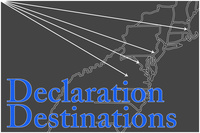
“... there is no quarter of the globe so desireable as America, no state in america so desireable as Virginia, no county in Virginia equal to Albemarle & no spot in Albemarle to compare to Monticello.” - Thomas Jefferson, 1795
Monticello, Thomas Jefferson’s home near Charlottesville, Virginia, is owned and operated by the Thomas Jefferson Foundation. Jefferson designed the Palladian-inspired home to sit atop the "little mountain," on land inherited from his father. From the North Terrace, through the trees, the Rotunda at the University of Virginia is visible, and in 1987, Monticello and the University of Virginia’s Academical Village together were named a UNESCO World Heritage Site. The house was the first American home to feature a dome, best viewed from the iconic “nickel” side.

The physical history of Monticello meshes with the timeline of Jefferson’s political career. Construction of Jefferson’s first iteration of the house began in 1769 and was completed by the time he left for France in 1784. After his time as Secretary of State in the early 1790s, Jefferson returned to the mountain and created a new design, which was completed by the time his second term as President of the United States concluded in 1809. One of several exhibitions on view in the David M. Rubenstein Visitor Center, “Making Monticello: Jefferson’s ‘Essay in Architecture’” details Jefferson’s designs and influences, and the enslaved and free workers who made his vision a reality. A video in this exhibition, “Putting Up & Pulling Down,” provides helpful animations of the different phases of construction.
 House tours take about 30 minutes, and tour guides use objects and architectural details around the house to tell the stories of both Jefferson family members and enslaved individuals. For example, an innovative revolving door in the dining room was installed so that enslaved people would cause as little disturbance to the diners as possible while transitioning from one course to the next. Outside the house, visitors can take a Slavery at Monticello tour, offered several times a day year round. This tour and companion app give a more detailed account of the enslaved people living and working on Mulberry Row.
House tours take about 30 minutes, and tour guides use objects and architectural details around the house to tell the stories of both Jefferson family members and enslaved individuals. For example, an innovative revolving door in the dining room was installed so that enslaved people would cause as little disturbance to the diners as possible while transitioning from one course to the next. Outside the house, visitors can take a Slavery at Monticello tour, offered several times a day year round. This tour and companion app give a more detailed account of the enslaved people living and working on Mulberry Row.
The Declaration
Records show that Thomas Jefferson had copies of the 1818 Benjamin Owen Tyler, 1819 John Binns, and 1823 Stone engravings, but it is not clear where exactly these copies ended up after Jefferson’s death. Nevertheless, actual copies or facsimiles of all three documents are on view in the house and Visitor's Center. The elaborate Binns engraving is on the left side of the fireplace in the South Square Room, which functioned for a time as Martha Jefferson Randolph's study, and Benjamin Owen Tyler's engraving hangs in the Library. An engraving based on Trumbull’s painting also hangs above the fireplace in the entrance hall.
The Michelle Smith Gallery in the Visitor Center is home to “Thomas Jefferson and the ‘Boisterous Sea of Liberty,’” an interactive exhibition where the Declaration of Independence serves as a conceptual hinge between what government was and what government would become. Portraits, documents, and quotes sweep across the screens like waves, and touch screen panels allow visitors to dive into “droplets” of more detail. The exhibition takes its name from a phrase Jefferson employed in two letters written in 1820: “the boisterous sea of liberty is never without a wave.”
The online exhibition “Slavery at Jefferson’s Monticello: Paradox of Liberty” features a section on the Declaration of Independence.
Other Things to See
- In Jefferson’s Cabinet, a plaster bust of John Adams after J.B. Binon faces Jefferson’s alcove bed, recalling their rekindled friendship in old age and their deaths just hours apart. The Cabinet also features a polygraph developed by Charles Willson Peale, an instrument designed to create a copy of a letter as it was written – Jefferson professed in 1809 that he “could not, now therefore, live without the Polygraph.”
- The Parlor features portraits of the “three greatest men that have ever lived” – Sir Francis Bacon, Sir Isaac Newton, and John Locke – along with Benjamin Franklin, George Washington, John Adams, and the Marquis de Lafayette. In this room there is also a much small portrait, a miniature painted by John Trumbull in 1788 as a study for his Declaration of Independence.
- Thomas Jefferson is buried in his family’s graveyard at Monticello, beneath an obelisk inscribed specifically according to Jefferson’s instructions.
Can't make it to Charlottesville? Monticello’s website and companion sites are brimming with resources on Jefferson, the house, and slavery. The Thomas Jefferson Encyclopedia is a great tool with articles organized by categories, and several rooms of the house can be explored in this 360 degree virtual tour. Teachers can also check out the Monticello Digital Classroom.
Plan Your Visit
- Location: 931 Thomas Jefferson Parkway, Charlottesville, VA 22902 (GPS address)
- Hours: Daily, hours vary by season; closed on Christmas Day.
- Admission: Day passes, annual passes, and tours available; prices vary by season
www.monticello.org
Twitter: @TJMonticello
Instagram: @TJMonticello

